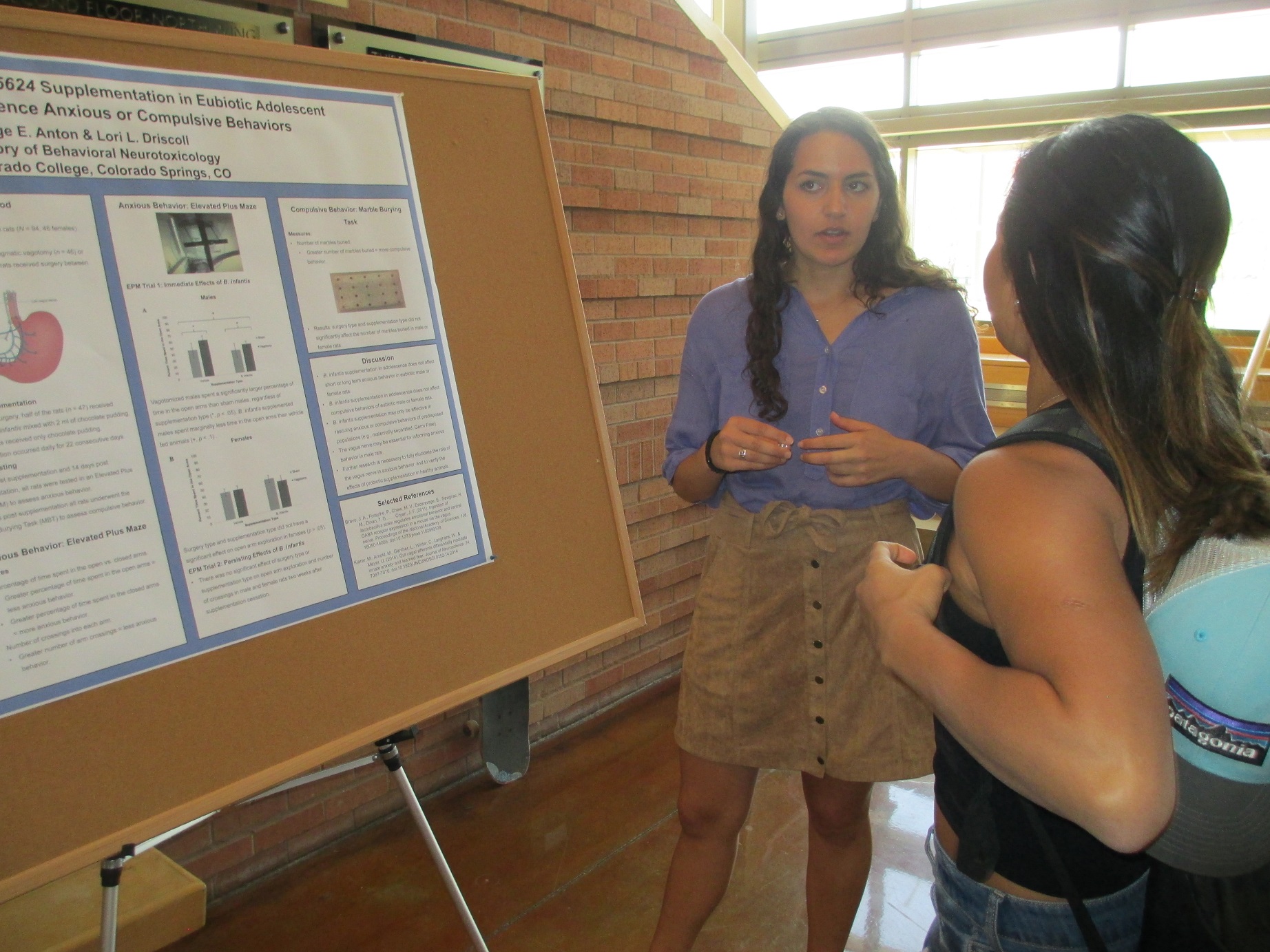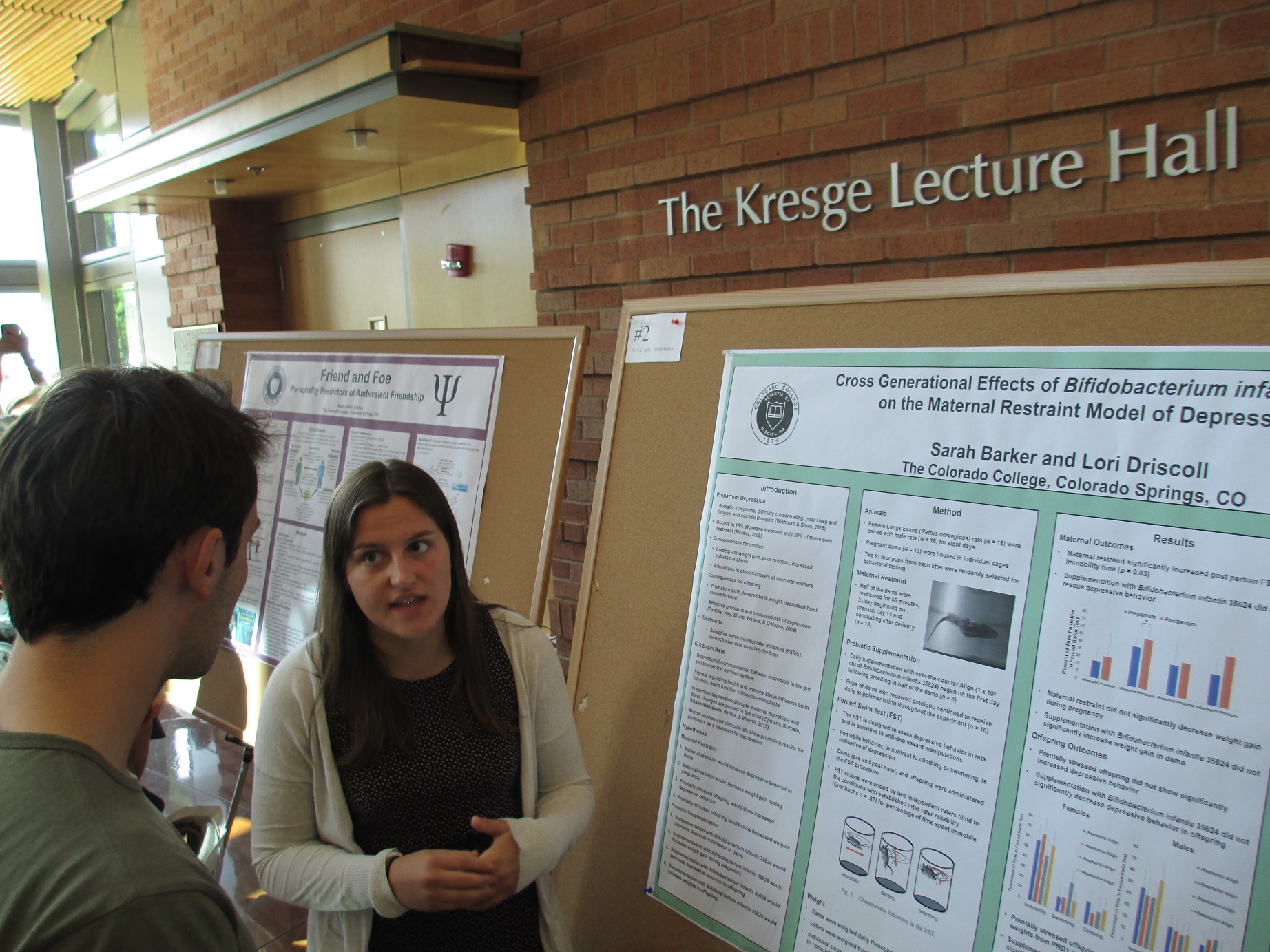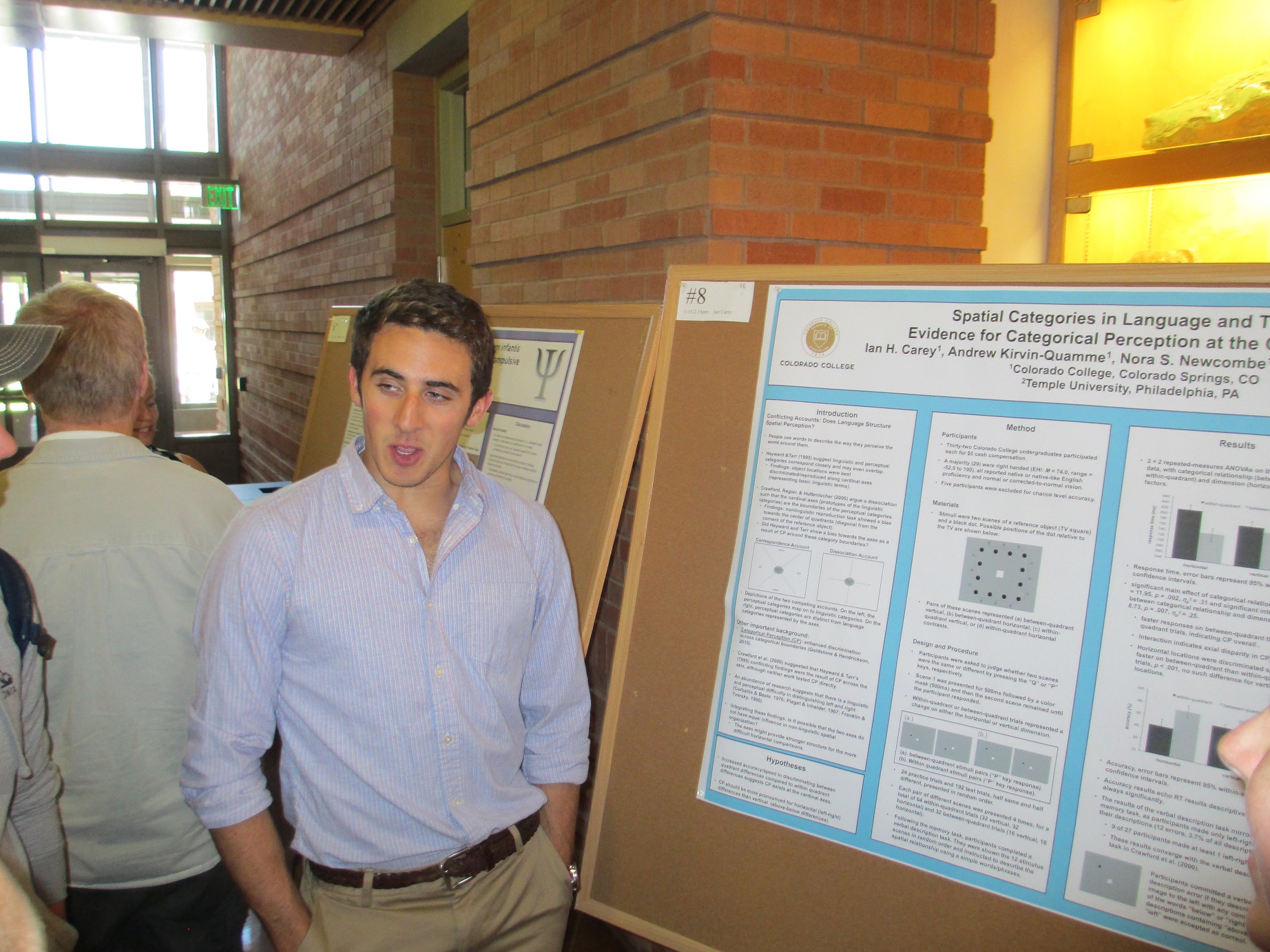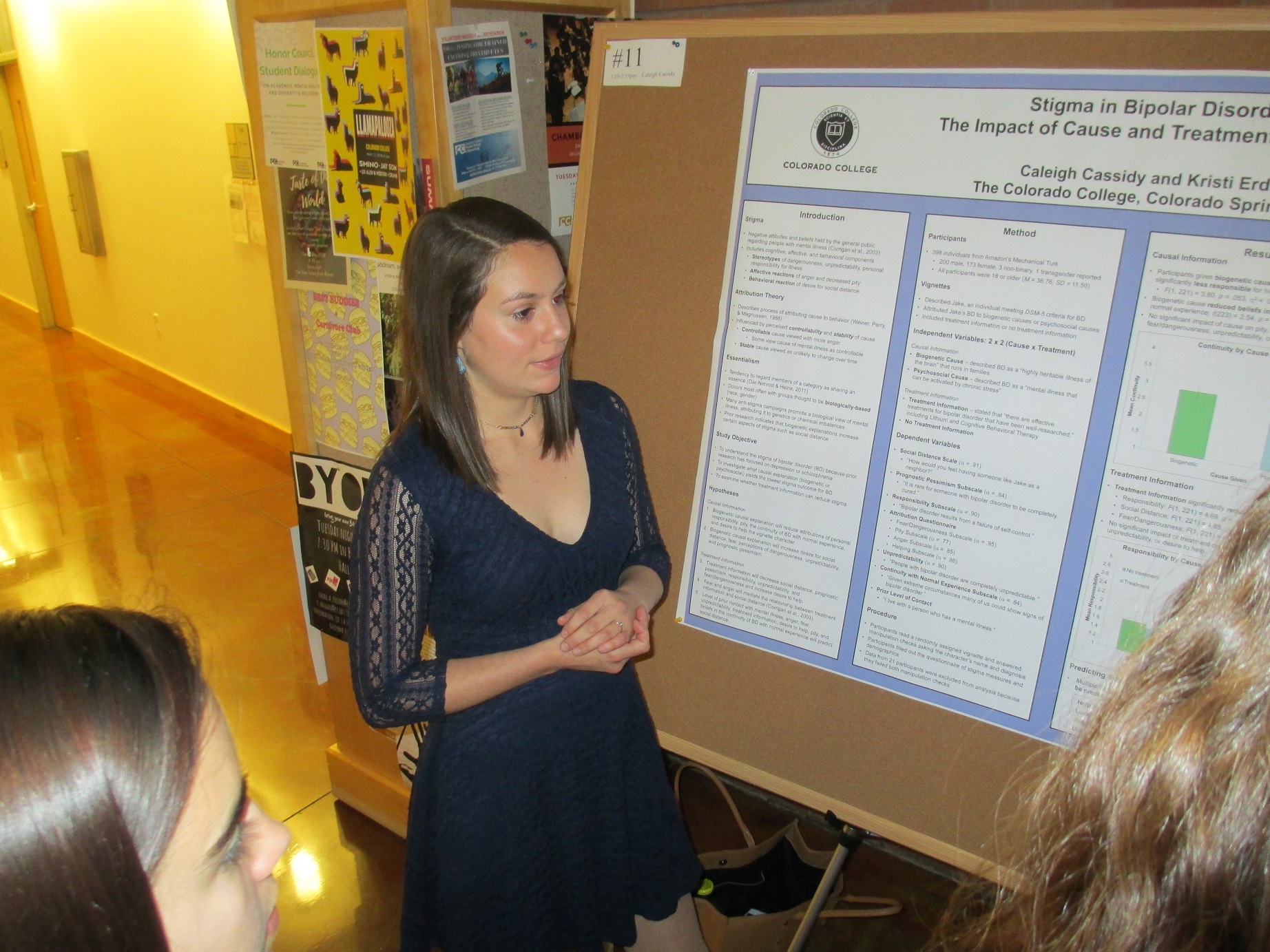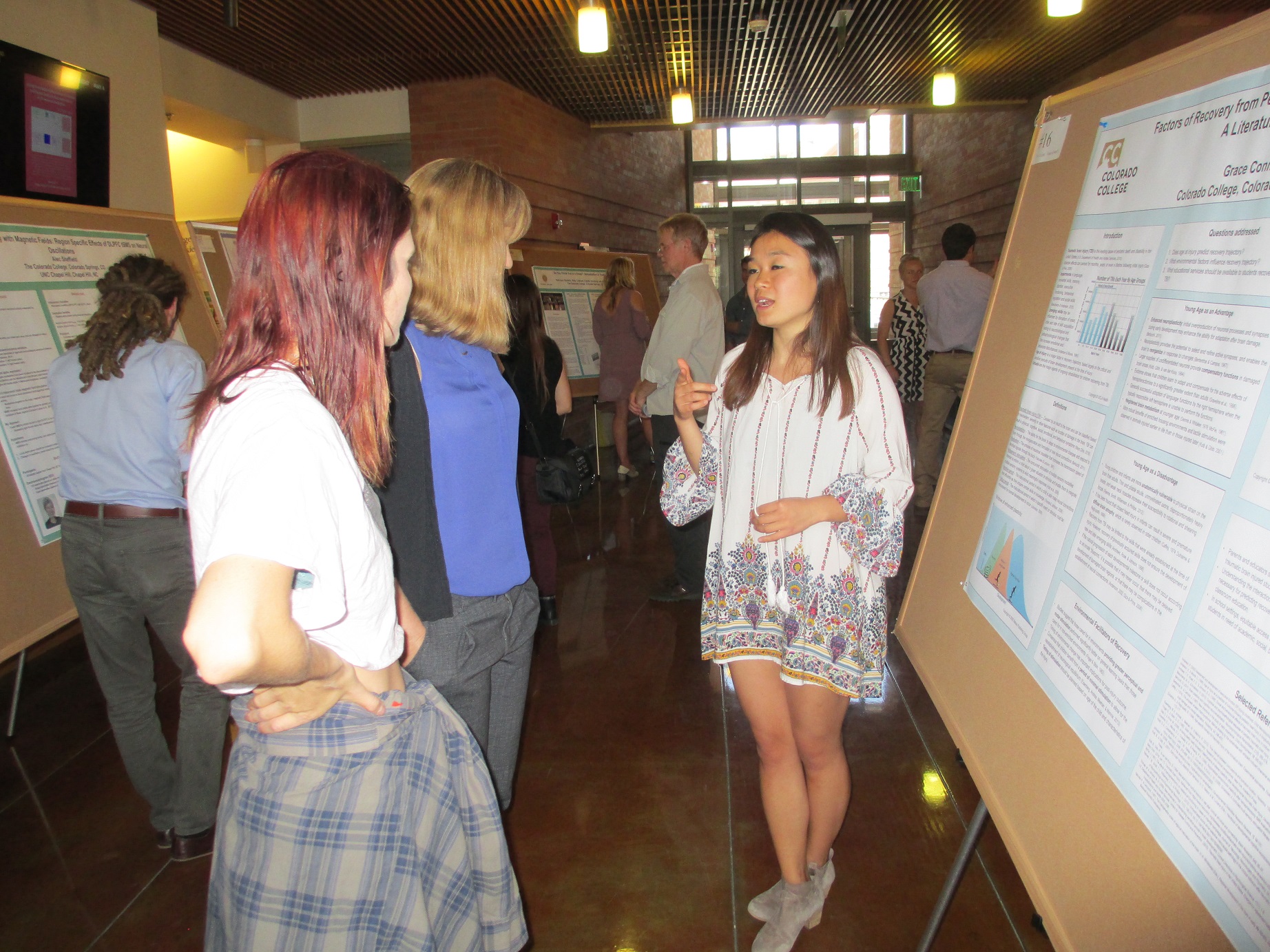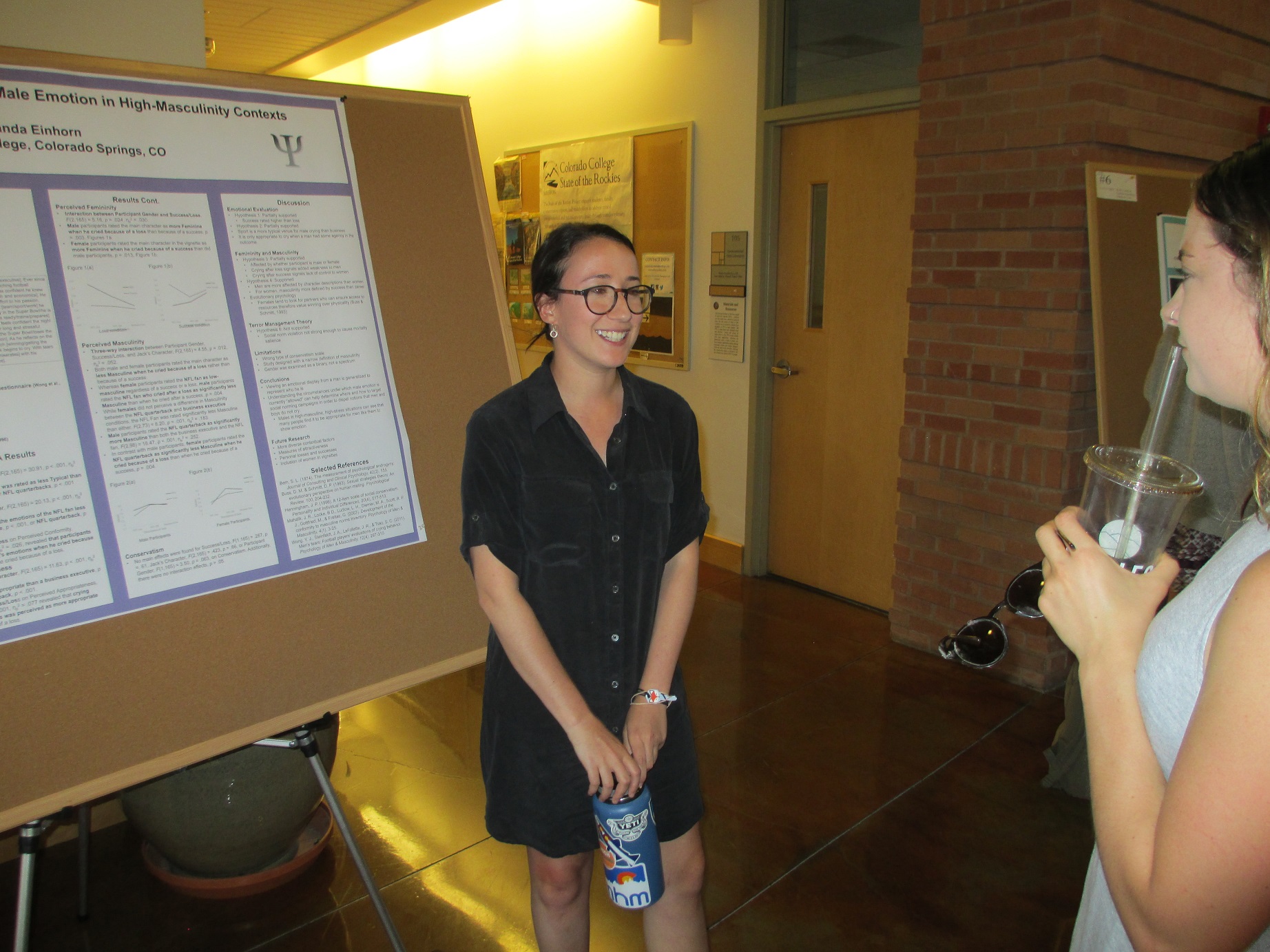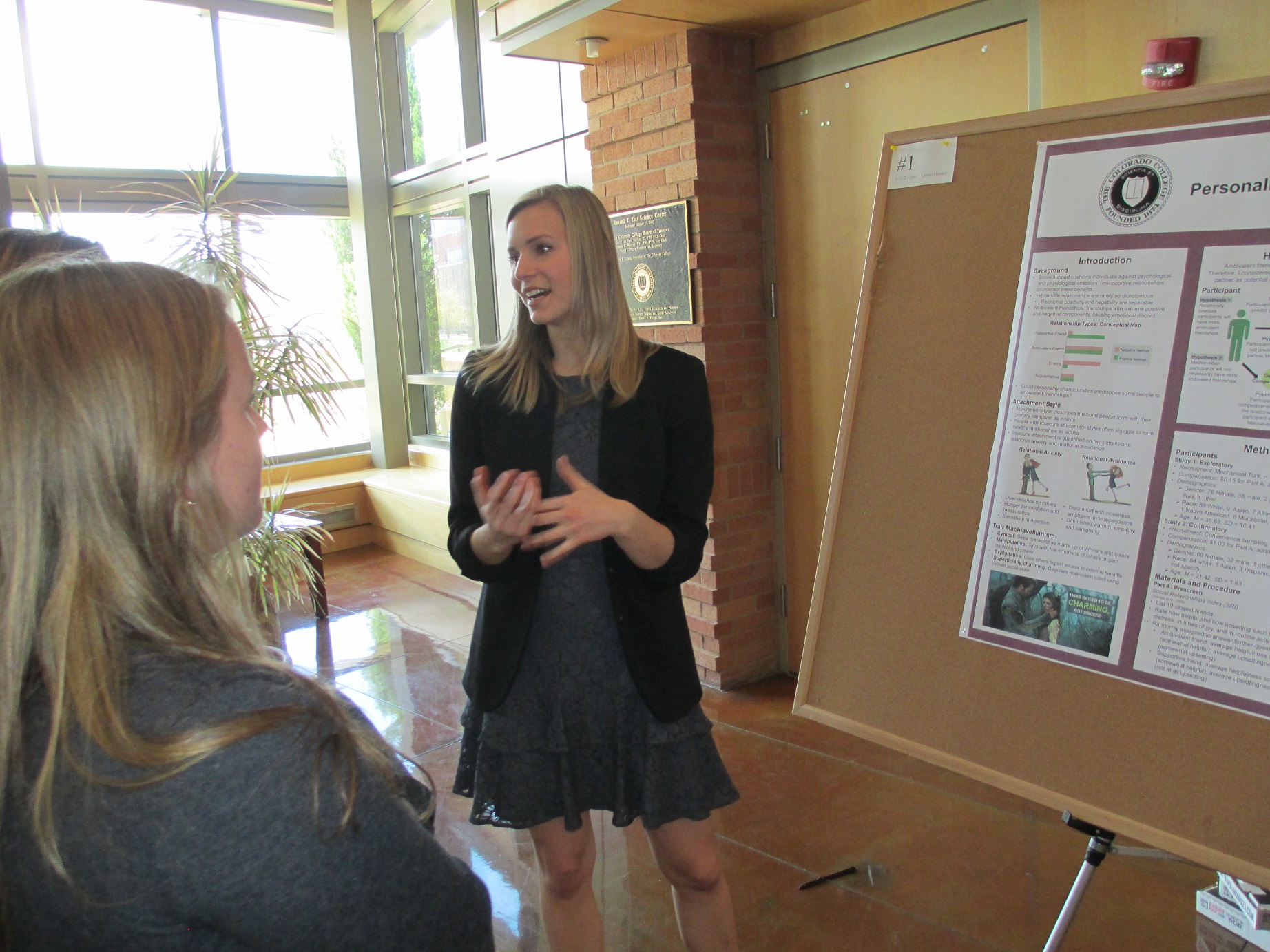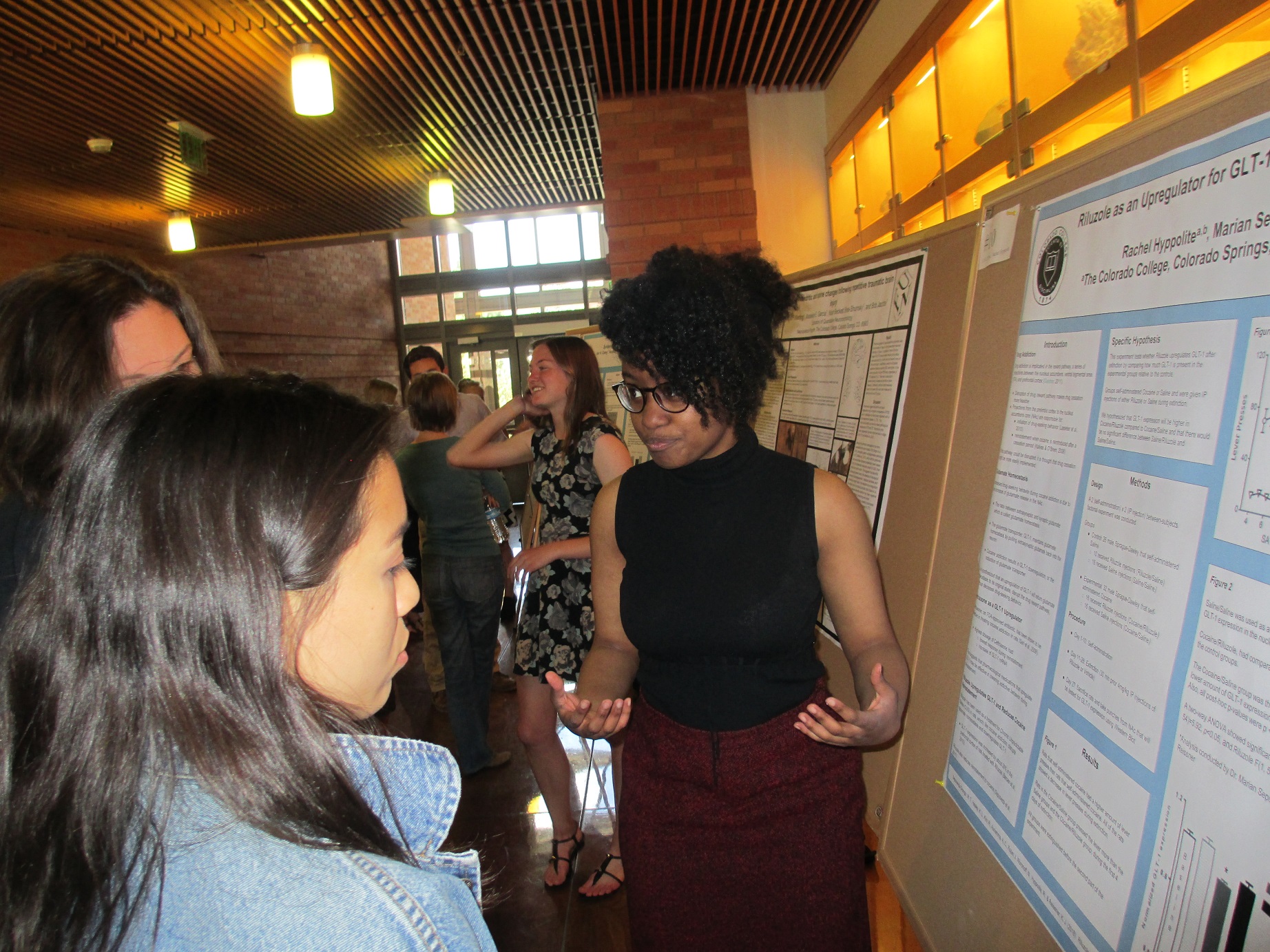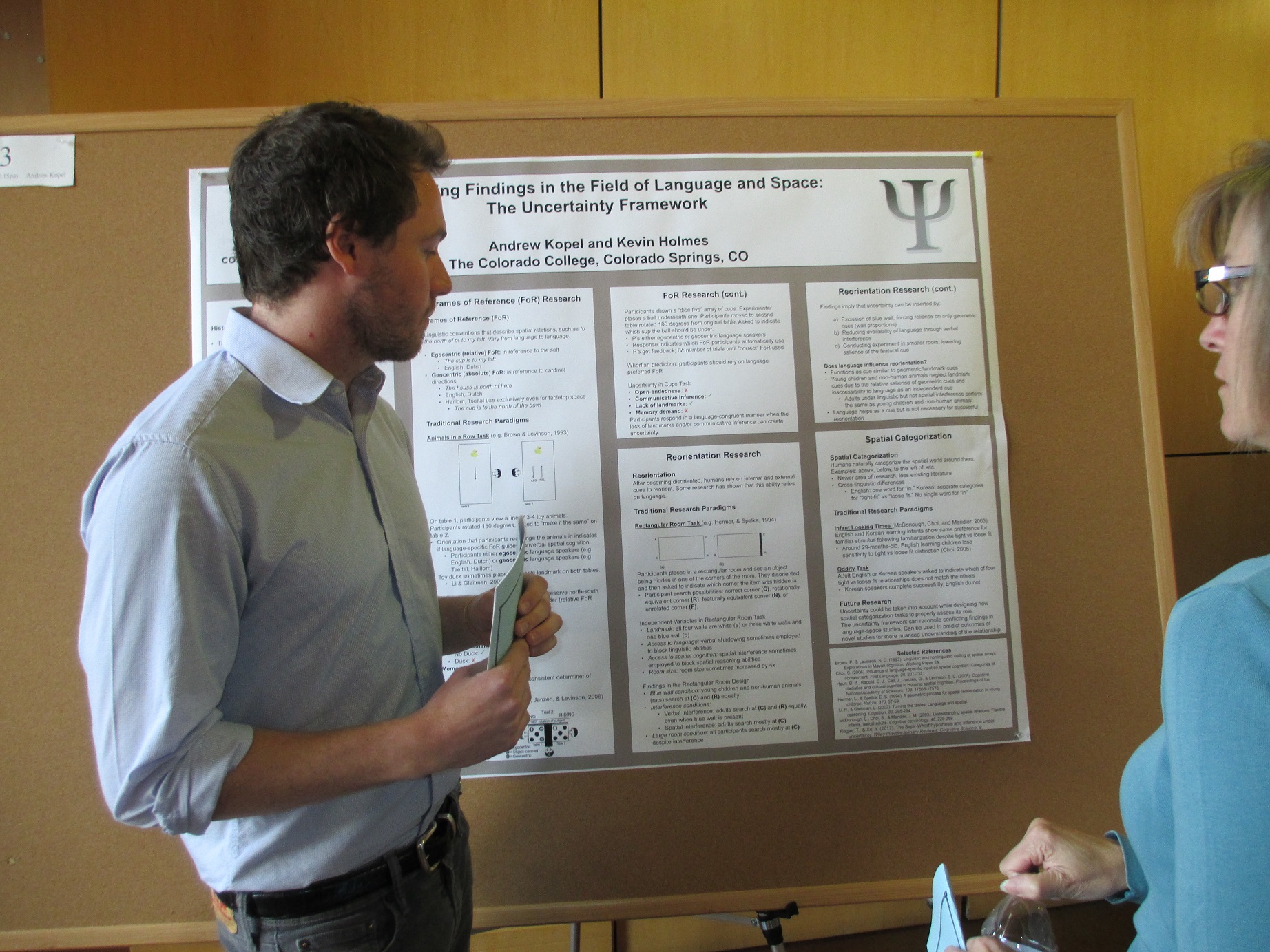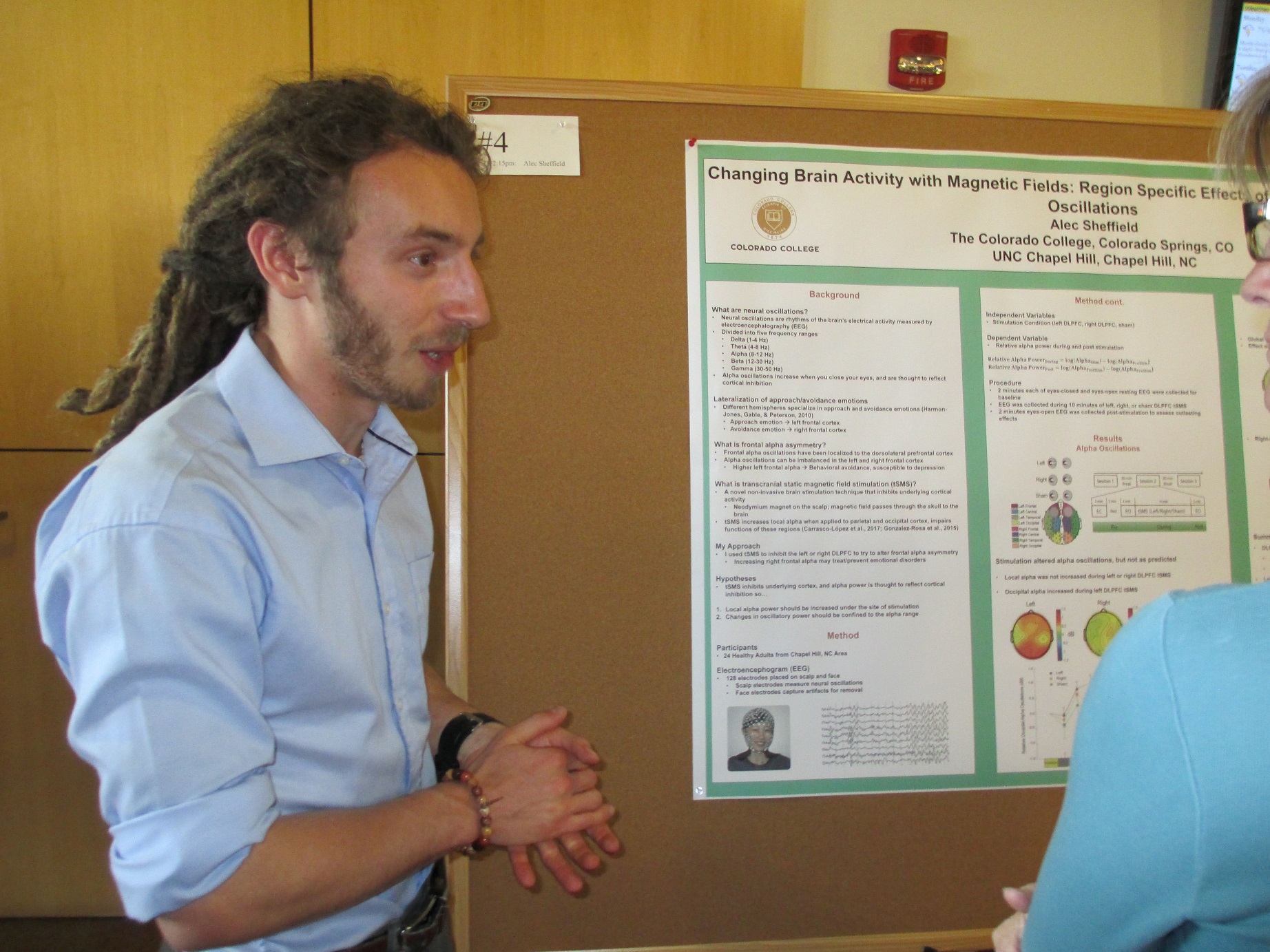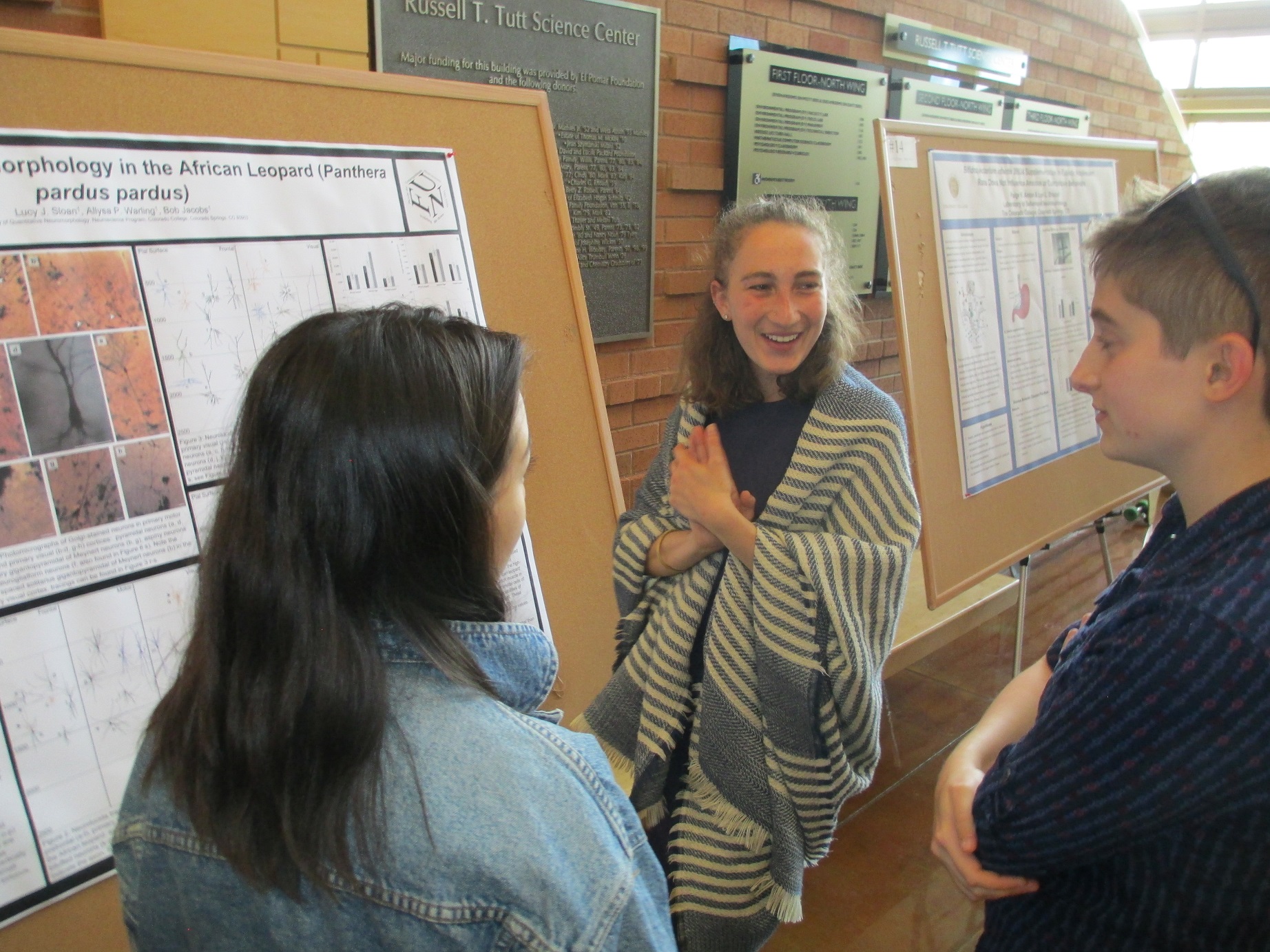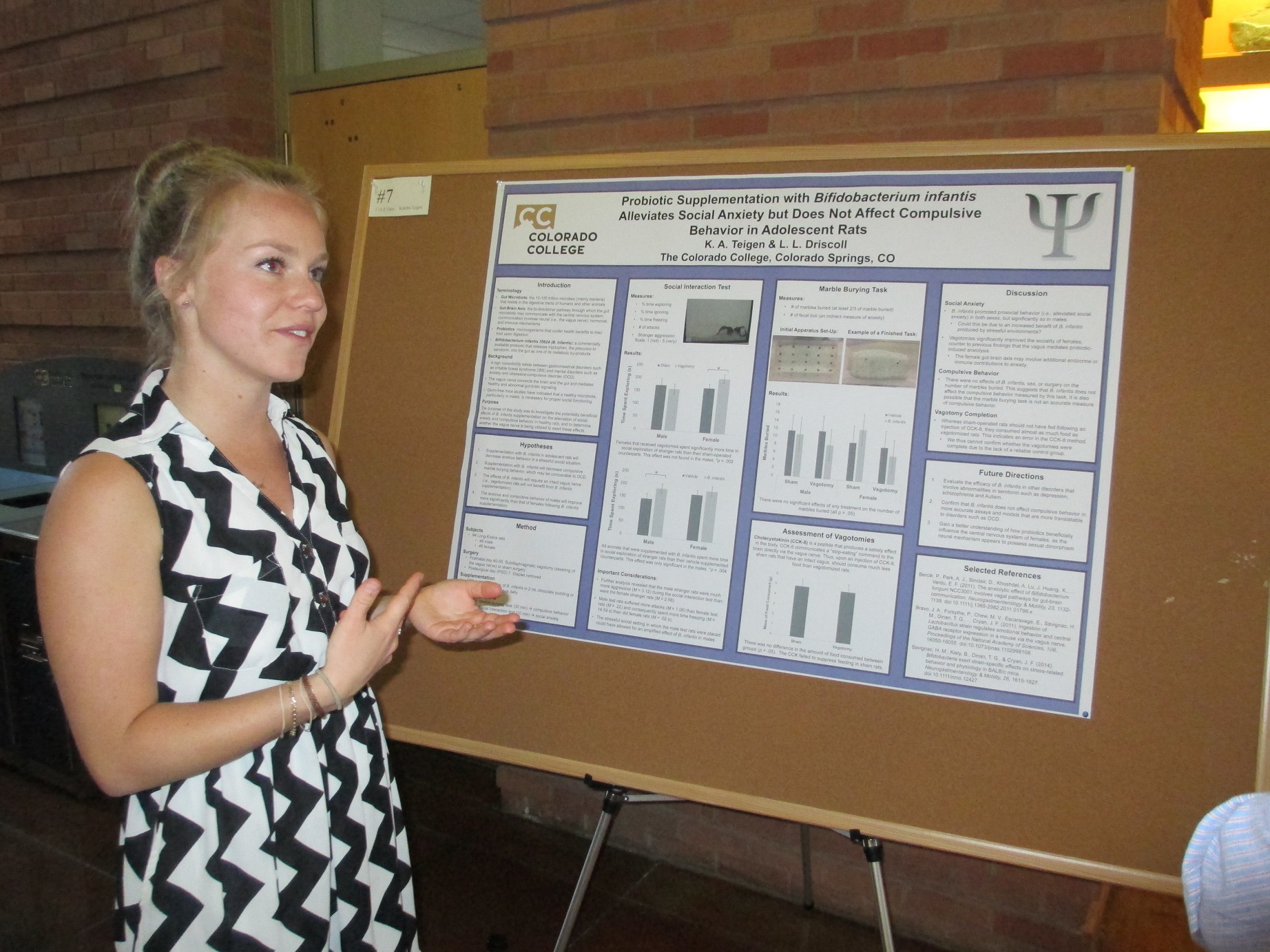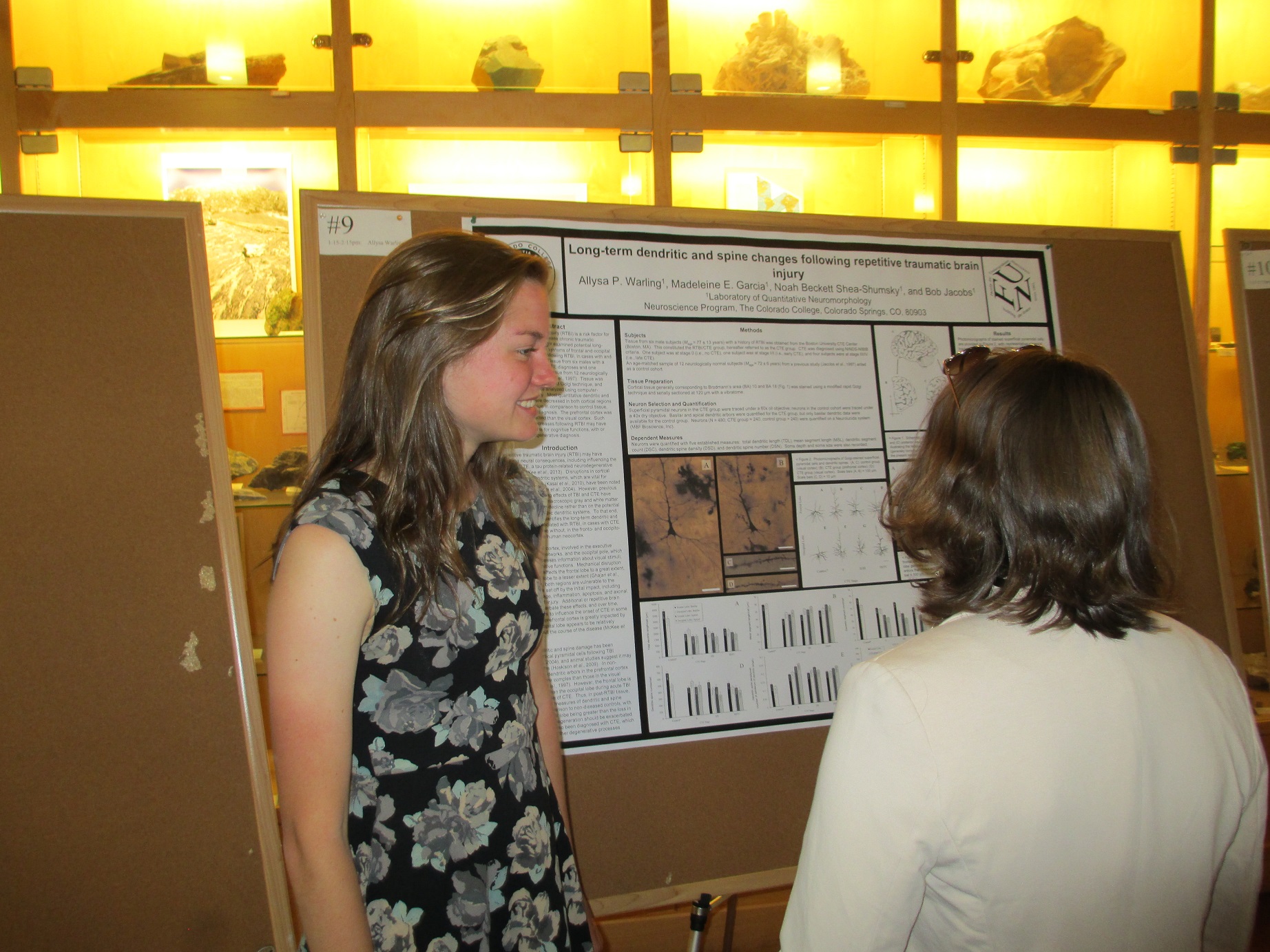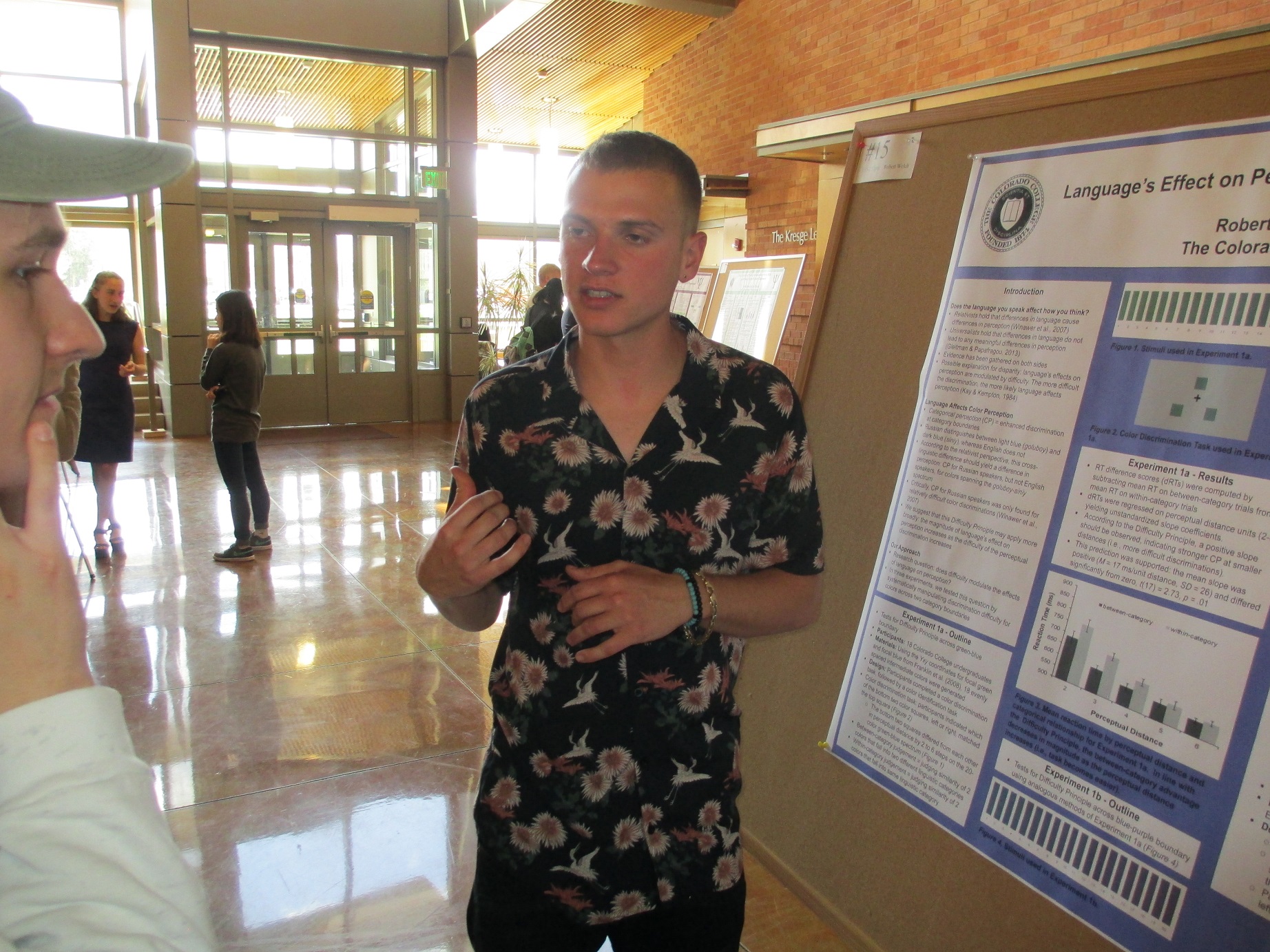Poster Day 2018
Neuroscience
Advisor: Lori Driscoll
Bifidobacterium infantis 35624 Supplementation in Eubiotic Adolescent Rats Does Not Influence Anxious or Compulsive Behaviors
Gut microbes communicate with the brain through endocrine, immune, and neural signaling. A healthy gut microbiome early in life plays a vital role in shaping neuropsychiatric function, but the relative influences of specific microbial strains, and the mechanisms by which these strains exert their effects, is unknown. The aim of the current study was to determine if probiotic supplementation with Bifidobacterium infantis 35624 (B. infantis) in adolescence impacts anxious and compulsive behaviors in healthy rats, and if these effects are dependent on vagus nerve signaling. Adolescent rats (N = 94) received a subdiaphragmatic vagotomy or sham surgery, and were then supplemented with B. infantis or a vehicle for 22 days. The rats were tested in two trials of an Elevated Plus Maze (EPM) at 0 and 2 weeks post-supplementation to assess immediate and persisting effects of B. infantis on anxiety. Compulsive behavior was measured using the Marble Burying Task (MBT). B. infantis did not significantly reduce anxious or compulsive behaviors in male or female rats; however, vagotomy significantly reduced anxious behavior in males in the EPM Trial 1. The present results suggest that B. infantis supplementation in adolescence does not influence anxious or compulsive behaviors in rats with established gut microbiota, and that the vagus nerve may be important for informing anxious behavior in males. Further research is necessary to fully elucidate the role of the vagus nerve in anxious behavior, and to verify the long-term effects of probiotic supplementation on anxious and compulsive behavior in healthy animals.
Psychology
Advisor: Kristi Erdal
Treatment Changes and Improvements for Athletes with Eating Disorders
Eating disorders (EDs) are the result of a combination of unrealistic cultural pressures, susceptible personality traits, and dysfunctional cognitive processes. For athletes, the combination of cultural expectations and pressures to perform competitively results in a greater risk of developing EDs. The common trait of perfectionism in EDs manifests itself in athletes in the demand for competitive excellence and extreme measures taken to increase performance, resulting, for many women, in the Female Athlete Triad: disordered eating, amenorrhea, and osteoporosis. Understanding what causes treatment resistance in athletes with EDs may help to improve current treatment methods and improve motivation for treatment. Current treatment options for disordered athletes evoke great anxiety. New treatment methods should aim to work with both the athlete and the athletic staff to increase prevention and education methods, as well as provide adequate nutritional information. The dangers of disordered eating on performance and health must be discussed. Cognitive behavioral therapy (CBT) and cognitive behavior coaching (CBC) techniques should be used to help change athlete preoccupations with performance and overly self-critical evaluations. Although stigmatized, exercise may prove beneficial in maintaining weight gain while decreasing anxiety and depression. Meditation-based techniques also help in decreasing anxiety and depression and may be useful in restructuring negative affect in athletes. Health, not performance, must be the main focus of the athlete, coaches, athletic staff and treatment team.
Neuroscience
Advisor: Lori Driscoll
Cross Generational Effects of Bifidobacterium infantis 35624 on the Maternal Restraint Model of Depression
Depression during pregnancy is a significant public health issue, with 18% of pregnant women suffering from depressive symptoms. Prepartum depression is correlated with health complications in the mother, and with physical and behavioral abnormalities in the child. Psychotherapy provides relief to some, but is not available to all, and the safety of antidepressant use during pregnancy has not been conclus1ively demonstrated. An alternative approach is to address the health of the gut brain axis, a bidirectional signaling pathway between gut microbiota and the central nervous system. Probiotics, capsules of viable and beneficial microorganisms, are an efficacious way to change the composition of the gut microbiota and subsequently improve central nervous system disorders such as depression and anxiety. The present study explores the cross generational effects of Bifidobacterium infantis 35624 supplementation on the maternal restraint model of depression in rats. Maternal restraint for 45 minutes three times a day, for six to seven days, significantly increased dams' depressive behavior. Maternal restraint additionally increased offspring weights and depressive behavior. Bifidobacterium infantis 35624 supplementation marginally rescued these deficits. Although few results reached statistical significance, further research with a larger sample size is warranted to elucidate the efficacy of this intervention in improving the physical and psychological health of mother and infant.
Ian Carey & Andrew Kirvin-Quamme
Psychology
Advisors: Kevin Holmes & Nora S. Newcombe
Spatial Categories in Language and Thought: Evidence for Categorical Perception at the Cardinal Axes
The relationship between linguistic and nonlinguistic spatial categories has been characterized in terms of two contrasting positions. One position suggests, naturally enough, a close correspondence between the two sets of categories. The other position suggests a dissociation, in which the horizontal and vertical axes function as the boundaries of nonlinguistic categories and the protoypes of linguistic categories. The latter account predicts categorical perception (CP) at the axes, revealed by superior discrimination of locations straddling an axis compared to non-axial locations-yet this prediction has not been tested directly. We provide evidence for such axial CP in two experiments using perceptual and memory tasks. A third experiment replicates these results, but exposes an important caveat. Much research indicates that left and right are more confusable in language than above and below, and CP reflects this disparity: the relative difficulty of discriminating non-axial locations was more pronounced when the locations were separated horizontally than vertically. Together, these results indicate that the relationship between linguistic and nonlinguistic spatial categories is not fully captured by either existing account. That the axes yield CP suggests that they indeed function as nonlinguistic category boundaries, supporting the dissociation account. However, the disparity in CP between the axes-mirroring, and perhaps reinforced by, the linguistic privileging of vertical over horizontal terms-indicates that linguistic and nonlinguistic spatial categories are in fact aligned to a considerable degree, though not in the way proposed by the correspondence account.
Psychology
Advisor: Kristi Erdal
Stigma in Bipolar Disorder: The Impact of Cause and Treatment Information
Public stigma continues to present a barrier to recovery for individuals with mental illness. Prior research suggests that biogenetic causal explanations of mental illness increase certain aspects of stigma. However, most of that research was specific to depression and schizophrenia, and few studies have explored the stigma of bipolar disorder. Therefore, the present study examined the impact of cause and treatment information on stigma in bipolar disorder. Participants on Amazon's Mechanical Turk completed a questionnaire containing a vignette of someone with bipolar disorder that varied the cause and treatment information. When given a biogenetic cause, participants judged people with bipolar disorder to be less responsible for their illness, but they also viewed bipolar disorder as less continuous with normal experience. Treatment information reduced fear, perceptions of dangerousness, desire for social distance, and patient responsibility. Pity and fear mediated the relationship between treatment information and social distance. These results suggest the importance of providing treatment information in destigmatization campaigns.
Neuroscience
Advisor: Kristi Erdal
Factors of Recovery from Pediatric Traumatic Brain Injury: A Literature Review
Childhood traumatic brain injury (TBI) is the leading cause of pediatric death and disability in the United States. Disruption to critical developmental brain processes can result in TBI effects that extend for months, years, or even a lifetime following initial injury. Age at injury is a major factor in recovery trajectory, based largely on the critical and sensitive periods of brain development present at the time of injury. Suffering from TBI during a critical or sensitive period could result in optimal recovery trajectory as a function of heightened brain plasticity, or in contrast, result in irrevocable damage to continued development by dismantling crucial neuronal processes. The present review examines literature discussing both the advantages and disadvantages of younger age at injury, as well as explores the implications of TBI in the school setting. Access to high-quality intervention and informed educators should be available to all students, regardless of a family's ability to pay for services. Suggestions for rehabilitative strategies are provided with respect to a child's current cognitive, behavioral, social and emotional capacities, as well as ongoing developmental processes. Because every injury is different and requires a unique approach to intervention, this review emphasizes the responsibility of schools to create and implement intervention plans that suit individual children and address their unique cognitive, social, emotional and behavioral development.
Kelly Culshaw, Camille Ginsburg, & Matthew Cole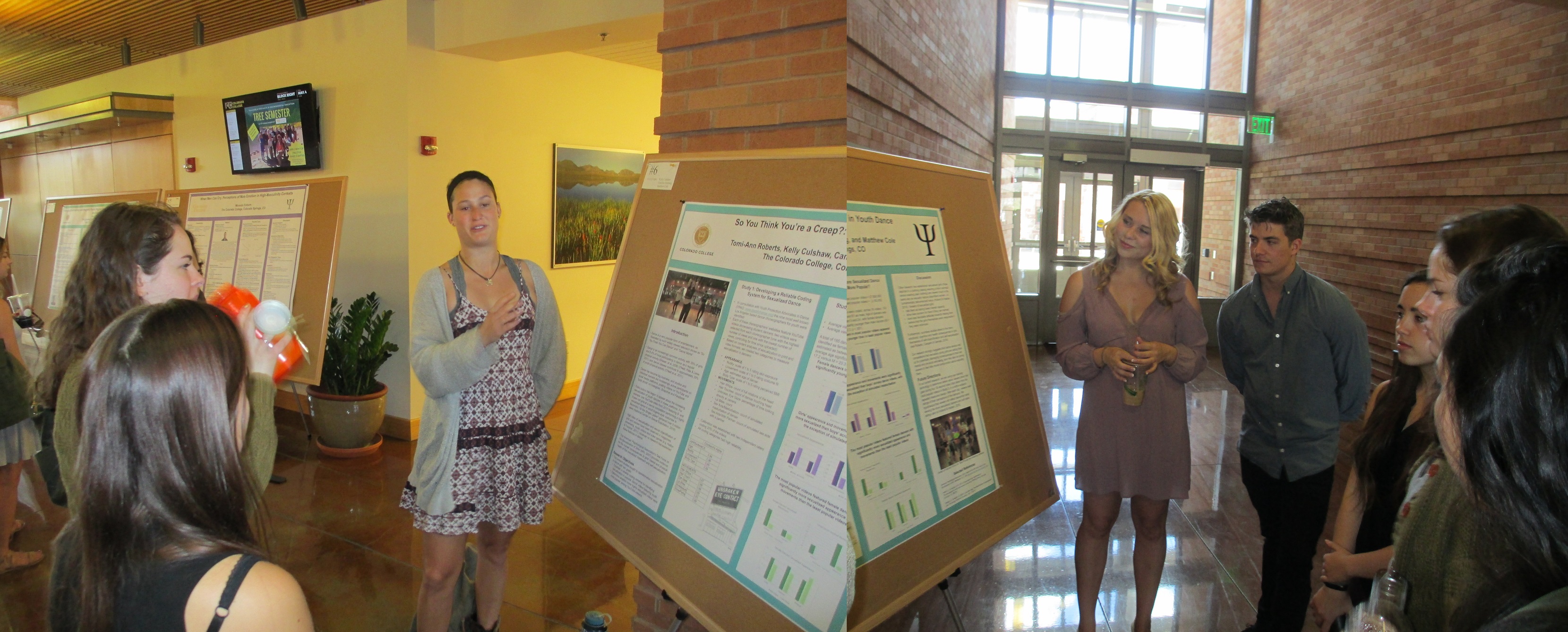
Psychology
Advisor: Tomi-Ann Roberts
So You Think You're a Creep? Sexualization in Youth Dance
Two studies explored sexualization in popular YouTube dance videos featuring youth. Study one established a reliable coding scheme for sexualized appearance and sexualized movements. Videos with the most views had significantly greater sexualization than those with the fewest. Study two used eye tracking to confirm these elements in naive participants.
Psychology
Advisor: Kristi Erdal
When Men Cry: Perceptions of Male Emotion in High Masculinity Contexts
Research on male emotion and male tears shows that contextual and situational cues have the greatest effects on evaluations of these behaviors by others. Guided by both social constructionist and social norms perspectives on masculinity, this study examined people's evaluations of male crying behavior in specifically high-masculinity situations. Using an experimental design, 180 participants were randomly assigned to one of six conditions in which they read a vignette about Jack, a male who cries after a success or loss. To investigate the effect of labels on emotional evaluation, Jack was described as either a business man, football fan, or football quarterback. Evaluations of Jack's behavior were rated on its typicality, appropriateness, and anticipated participant conformity with the behavior; Jack was rated on his femininity and masculinity. Finally, participants answered a conservatism questionnaire. The results showed that while support of sports is considered typical for males, fans are not directly involved enough to the point where crying is socially appropriate. In addition, two- and three-way interactions showed that perceptions of femininity and masculinity vary according to participant gender. Females seemed to associate masculinity with success whereas males were more sensitive to the description of the character.
Psychology
Advisor: Jason Weaver
Friend and Foe: Personality Predictors of Ambivalent Friendship
Though friendship is often conceptualized in polar terms-as friend or foe-friendship is rarely so dichotomous. Ambivalent friendships, characterized by a mix of positive and negative emotions, are just as common as they are distressing (Bushman & Holt-Lunstad, 2009; Campo et al., 2009). The present study investigates personality predictors of ambivalent friendship, focusing on relational insecurity and trait Machiavellianism as catalysts of ambivalent friendship. In two self-report studies, participants rated their own personality traits, then the personality traits of either supportive friend or an ambivalent friend. Across studies, ambivalent friends were perceived to be both more relationally insecure and more Machiavellian than supportive friends. Relationally insecure participants rated a greater proportion of their friendships as ambivalent; yet participant Machiavellianism was unrelated to ambivalent friendship identification. These findings elucidate the role of personality variables in the perception and identification of ambivalent friendships.
Neuroscience
Advisors: John Horner, Kathryn Reissner, Marian Sepulveda
Riluzole as an Upregulator for GLT-1 with Implications for Cocaine Addiction
A pharmacological way to combat cocaine relapse is to restore biological conditions to their original state, by attempting to reduce the response to the drug after a period of cessation known as reinstatement. Previous experiments have concluded that drugs, such as Ceftriaxone, that restore glutamate levels in the nucleus accumbens thereby reducing reinstatement through upregulation of the glutamate transporter GLT-1. Riluzole has also been found to reduce reinstatement to cocaine. In this experiment, Sprawley-Dague rats self-administered either cocaine or saline for 10 days, then underwent extinction, during which cocaine was no longer self-administrated. During extinction, half of both groups received intraperitoneal (IP) injections of Riluzole for 16 days. The rats were then sacrificed, and GLT-1 expression was measured in the nucleus accumbens core using Western Blot. Experimental groups that received IP injections of Riluzole had similar levels of GLT-1 expression in the nucleus accumbens as the control group. However, the group that self-administered cocaine and received saline IP injections had a significantly lower amount of GLT-1 expression in the nucleus accumbens. Thus Riluzole appears to mediate the mechanism of GLT-1 upregulation to combat reinstatement, which implies that this mechanism is valuable for future pharmacological treatment of cocaine addiction.
Psychology
Advisor: Kevin Holmes
Reconciling Findings in the Field of Language and Space: The Uncertainty Framework
Mixed findings on the existence or lack of an influence of language on spatial cognition are reconciled by considering cognitive uncertainty as a modulator of the effects of language. When a situation provides an individual with uncertainty, language is more likely to influence the individual's decisions than if the situation is relatively certain. Language can be a tool to help reduce uncertainty, but language is not privileged as an uncertainty-reducing cue (its function is not categorically different from other cues). In this way, the present review seeks to normalize language's role and predict when and how it will influence spatial cognition.
Neuroscience
Advisor: Flavio Fröhlich
Changing Brain Activity with Magnetic Fields: Region Specific Effects of Prefrontal tSMS on Neural Oscillations
Transcranial static magnetic field stimulation (tSMS) is a novel non-invasive brain stimulation technique that has been shown to locally increase alpha oscillations in the parietal and occipital cortex. We investigated if tSMS locally increased alpha oscillations in the left or right prefrontal cortex, as the balance of left/right prefrontal alpha oscillations (frontal alpha asymmetry) has been linked to emotional processing and mood disorders. Therefore, altering frontal alpha asymmetry with tSMS may serve as a novel treatment to psychiatric diseases. EEG data were collected before, during, and after 10 minutes of tSMS applied to the left dorsolateral prefrontal cortex (DLPFC), right DLPFC, or sham. In contrast to our hypothesis, neither left nor right tSMS locally increased frontal alpha oscillations. However, alpha oscillations were higher in occipital cortex relative to other brain regions during left DLPFC tSMS. Both left and right DLPFC tSMS increased post-stimulation global theta oscillations relative to sham, with a greater increase in response to right stimulation. Beta oscillations in the left hemisphere increased post-stimulation for left and right DLPFC tSMS compared to sham. We concluded that DLPFC tSMS modulated the network oscillations in regions distant from the location of stimulation.
Neuroscience
Advisor: Bob Jacobs
Neocortical Neuronal Morphology in the African Leopard (Panthera pardus pardus)
The present study quantified the somatodendritic morphology of the African leopard (Panthera pardus pardus) neocortex for the first time, expanding a recent catalogue of non-domestic feline neuromorphology (Johnson et al., 2016). Tissue samples were obtained from the frontal, motor, and visual cortices, stained using a modified rapid Golgi technique, and quantified using computer-assisted morphometry. Qualitatively, a diverse range of spiny neurons and aspiny neurons were observed (N = 258), appearing similar to those previously observed in the domestic cat, as well as the Siberian tiger and clouded leopard. Quantitatively, the somatodendritic measures of all neurons traced in the African leopard were more similar in size and complexity to those of the clouded leopard than to those of the Siberian tiger. These results reflect a positive correlation between mammalian body size and neuronal sizes (Kaas, 2000) among these three species of Panthera. Lastly, these results are consistent with observations from Brodmann (1909) and Betz (1874) insofar as the gigantopyramidal neurons in the motor cortex were larger than expected, given African leopard body and brain size.
Neuroscience
Advisor: Lori Driscoll
Probiotic Supplementation with Bifidobacterium infantis Alleviates Social Anxiety but Does Not Affect Compulsive Behavior in Adolescent Rats
It has become increasingly evident that the commensal gut microbiota are capable of exerting substantial influence on the central nervous system, and that they likely play a role in the manifestations of neurological disorders. The exact route-be it neural, hormonal, or immune-through which this communication occurs has yet to be determined. The aim of the present study was to assess whether the probiotic Bifidobacterium infantis (B. infantis), which produces a serotonin precursor in the gut, was capable of alleviating anxious and compulsive behavior in adolescent rats, and if so, to what extent this effect is dependent upon the vagus nerve (i.e., neural communication). B. infantis treatment reduced anxious behavior during a social interaction test in both male and female rats, but only significantly so in the males. In contrast, probiotic supplementation had no effect on the occurrence of compulsive behavior in both sexes as measured by the marble burying test. Additionally, compromising the neural communicative pathway with subdiaphragmatic vagotomies did not affect the ability of B. infantis to attenuate anxious behavior. This study demonstrates that B. infantis possess anxiolytic properties, which are more pronounced in males, are amplified in the context of a stressful social situation, and do not appear to be mediated by the vagus nerve. Although more research is warranted, these findings support the proposed use of probiotics as alternatives to pharmaceuticals for the treatment of neurological diseases that have comorbidities with gut microbiota dysbiosis.
Allysa P. Warling, Madeleine E. Garcia, & Noah Beckett Shea-Shumsky
Neuroscience, Neuroscience, Psychology
Advisor: Bob Jacobs
Long-Term Dendritic and Spine Changes Following Repetitive Traumatic Brain Injury
Repetitive traumatic brain injury (RTBI) is a risk factor for the neurodegenerative disease chronic traumatic encephalopathy (CTE). We examined potential long-term changes in dendritic systems of frontal and occipital lobe pyramidal neurons following RTBI, in cases with and without CTE diagnoses. Tissue from six males with a history of RTBI, five with CTE diagnoses and one without, was compared to tissue from 12 neurologically normal individuals (Jacobs et al., 1997). Tissue was prepared with a rapid Golgi technique, and dendritic systems were analyzed using computer-assisted morphometry. Most quantitative dendritic and spine measures were decreased in both cortical regions in all post-RTBI tissue in comparison to control tissue, regardless of CTE diagnosis. The prefrontal cortex was more severely affected than the visual cortex. Such lasting dendritic decreases following RTBI may have negative implications for cognitive functions, with or without a neurodegenerative diagnosis.
Neuroscience
Advisor: Kevin J. Holmes
The Difficulty Principle: Language's Effect on Perceptual Discriminations Depends on Difficulty
Although much evidence suggests that language influences perceptual discrimination, relatively little research has explored factors that might modulate such effects. Some have proposed that effects of language may be stronger for more difficult discriminations than for easier ones, yet previous research has either tacitly assumed this idea or tested it in a manner that treats language's influence as all-or-none rather than graded. Here we provide evidence for graded effects of language across systematically varied levels of discrimination difficulty. Using color as a testbed, we show that categorical perception-enhanced discrimination at category boundaries-increases linearly with difficulty, defined by the perceptual similarity between colors. Evidence for the modulatory role of difficulty was observed across two different linguistic category boundaries and perceptual tasks. Our findings provide insight into the conditions under which language shapes perception the most strongly and begin to reconcile discrepancies within the field regarding whether language affects color perception.
show all / hide all



